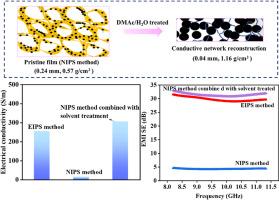通过溶剂膨胀诱导和微观结构优化提高pvc基电磁屏蔽复合膜的性能
IF 4.5
2区 化学
Q2 POLYMER SCIENCE
引用次数: 0
摘要
随着电磁干扰(EMI)的日益严重,开发高效、环保的屏蔽材料变得至关重要。传统的蒸发相分离(EIPS)方法存在制备周期长、溶剂挥发大、容易发生闪爆、填料沉降等问题。虽然非溶剂诱导相分离(NIPS)更环保,但其导电性和电磁干扰屏蔽效果(SE)仍然有限。为了解决这些挑战,本研究提出了一种创新的策略:首先通过NIPS制备聚氯乙烯(PVC)/炭黑(CB)/碳纳米管(CNT)复合薄膜,然后通过溶剂膨胀-热干燥工艺重建导电网络。NIPS法快速固定填料以防止沉降,而随后浸泡在DMAc/H2O混合溶剂(8:2质量比)中会引起PVC膨胀,促进填料的重新分布和致密化。在热干燥过程中,溶剂蒸发引起薄膜收缩,进一步优化填料的连通性。优化后的干燥温度为60℃,浸泡时间为20 min,薄膜厚度从0.24 mm减小到0.04 mm,电导率从16.5 S/m大幅提高到567.6 S/m,电磁干扰屏蔽效能(SE)从5.3 dB提高到18.1 dB。当薄膜厚度增加到0.2 mm时,EMI SE达到32.9 dB,优于传统EIPS制备的薄膜。该研究不仅克服了NIPS方法的导电性限制,而且避免了EIPS方法的安全风险,为制造轻质、高性能EMI屏蔽材料提供了一种新颖、更环保、更安全的方法。所提出的策略在柔性电子和通信设备中显示出巨大的应用潜力。本文章由计算机程序翻译,如有差异,请以英文原文为准。

Enhanced performance of PVC-based electromagnetic shielding composite films via solvent swelling-induced and microstructure optimization
With the growing severity of electromagnetic interference (EMI), developing efficient and more environmentally friendly shielding materials has become crucial. Traditional evaporation-induced phase separation (EIPS) methods suffer from long preparation cycles, significant solvent evaporation posing flash explosion hazards, and issues of filler sedimentation. Although non-solvent-induced phase separation (NIPS) is greener, its electrical conductivity and EMI shielding effectiveness (SE) remains limited. To address these challenges, this study proposes an innovative strategy: first preparing polyvinyl chloride (PVC)/carbon black (CB)/carbon nanotube (CNT) composite films via NIPS, followed by a solvent swelling-thermal drying process to reconstruct the conductive network. The NIPS method rapidly immobilizes fillers to prevent sedimentation, while subsequent immersion in a DMAc/H2O mixed solvent (8:2 mass ratio) induces PVC swelling, promoting filler redistribution and densification. During thermal drying, solvent evaporation induces film shrinkage, further optimizing filler connectivity. Under optimized conditions (60 °C drying temperature, 20 minutes soaking), the film thickness decreases from 0.24 mm to 0.04 mm, while electrical conductivity dramatically increases from 16.5 S/m to 567.6 S/m, and EMI shielding effectiveness (SE) improves from 5.3 dB to 18.1 dB. When the film thickness is increased to 0.2 mm, the EMI SE reaches 32.9 dB, outperforming films prepared by conventional EIPS. This study not only overcomes the electrical conductivity limitations of the NIPS method but also avoids the safety risks of the EIPS method, providing a novel, greener, and safer approach for the fabrication of lightweight, high-performance EMI shielding materials. The proposed strategy shows significant potential for applications in flexible electronics and communication devices.
求助全文
通过发布文献求助,成功后即可免费获取论文全文。
去求助
来源期刊

Polymer
化学-高分子科学
CiteScore
7.90
自引率
8.70%
发文量
959
审稿时长
32 days
期刊介绍:
Polymer is an interdisciplinary journal dedicated to publishing innovative and significant advances in Polymer Physics, Chemistry and Technology. We welcome submissions on polymer hybrids, nanocomposites, characterisation and self-assembly. Polymer also publishes work on the technological application of polymers in energy and optoelectronics.
The main scope is covered but not limited to the following core areas:
Polymer Materials
Nanocomposites and hybrid nanomaterials
Polymer blends, films, fibres, networks and porous materials
Physical Characterization
Characterisation, modelling and simulation* of molecular and materials properties in bulk, solution, and thin films
Polymer Engineering
Advanced multiscale processing methods
Polymer Synthesis, Modification and Self-assembly
Including designer polymer architectures, mechanisms and kinetics, and supramolecular polymerization
Technological Applications
Polymers for energy generation and storage
Polymer membranes for separation technology
Polymers for opto- and microelectronics.
 求助内容:
求助内容: 应助结果提醒方式:
应助结果提醒方式:


